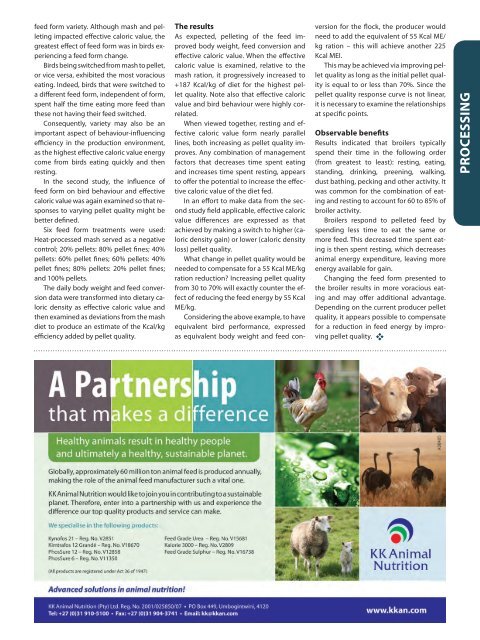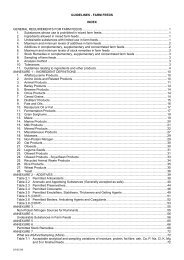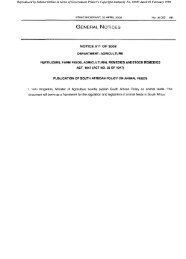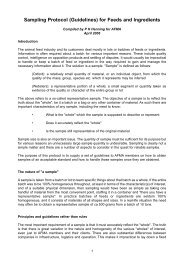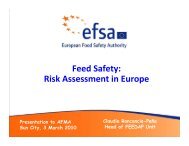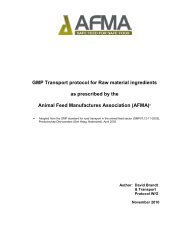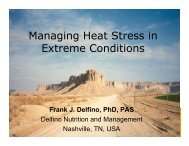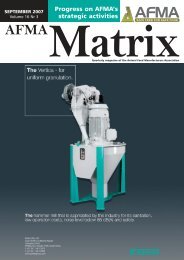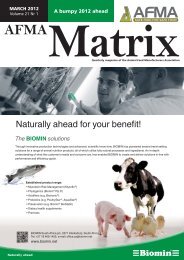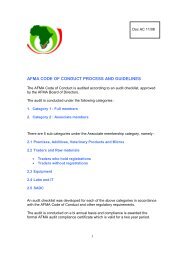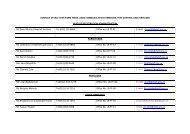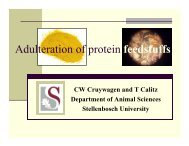Create successful ePaper yourself
Turn your PDF publications into a flip-book with our unique Google optimized e-Paper software.
feed form variety. Although mash and pelleting<br />
impacted effective caloric value, the<br />
greatest effect of feed form was in birds experiencing<br />
a feed form change.<br />
Birds being switched from mash to pellet,<br />
or vice versa, exhibited the most voracious<br />
eating. Indeed, birds that were switched to<br />
a different feed form, independent of form,<br />
spent half the time eating more feed than<br />
these not having their feed switched.<br />
Consequently, variety may also be an<br />
important aspect of behaviour-influencing<br />
efficiency in the production environment,<br />
as the highest effective caloric value energy<br />
come from birds eating quickly and then<br />
resting.<br />
In the second study, the influence of<br />
feed form on bird behaviour and effective<br />
caloric value was again examined so that responses<br />
to varying pellet quality might be<br />
better defined.<br />
Six feed form treatments were used:<br />
Heat-processed mash served as a negative<br />
control; 20% pellets: 80% pellet fines; 40%<br />
pellets: 60% pellet fines; 60% pellets: 40%<br />
pellet fines; 80% pellets: 20% pellet fines;<br />
and 100% pellets.<br />
The daily body weight and feed conversion<br />
data were transformed into dietary caloric<br />
density as effective caloric value and<br />
then examined as deviations from the mash<br />
diet to produce an estimate of the Kcal/kg<br />
efficiency added by pellet quality.<br />
The results<br />
As expected, pelleting of the feed improved<br />
body weight, feed conversion and<br />
effective caloric value. When the effective<br />
caloric value is examined, relative to the<br />
mash ration, it progressively increased to<br />
+187 Kcal/kg of diet for the highest pellet<br />
quality. Note also that effective caloric<br />
value and bird behaviour were highly correlated.<br />
When viewed together, resting and effective<br />
caloric value form nearly parallel<br />
lines, both increasing as pellet quality improves.<br />
Any combination of management<br />
factors that decreases time spent eating<br />
and increases time spent resting, appears<br />
to offer the potential to increase the effective<br />
caloric value of the diet fed.<br />
In an effort to make data from the second<br />
study field applicable, effective caloric<br />
value differences are expressed as that<br />
achieved by making a switch to higher (caloric<br />
density gain) or lower (caloric density<br />
loss) pellet quality.<br />
What change in pellet quality would be<br />
needed to compensate for a 55 Kcal ME/kg<br />
ration reduction? Increasing pellet quality<br />
from 30 to 70% will exactly counter the effect<br />
of reducing the feed energy by 55 Kcal<br />
ME/kg.<br />
Considering the above example, to have<br />
equivalent bird performance, expressed<br />
as equivalent body weight and feed conversion<br />
for the flock, the producer would<br />
need to add the equivalent of 55 Kcal ME/<br />
kg ration – this will achieve another 225<br />
Kcal MEI.<br />
This may be achieved via improving pellet<br />
quality as long as the initial pellet quality<br />
is equal to or less than 70%. Since the<br />
pellet quality response curve is not linear,<br />
it is necessary to examine the relationships<br />
at specific points.<br />
Observable benefits<br />
Results indicated that broilers typically<br />
spend their time in the following order<br />
(from greatest to least): resting, eating,<br />
standing, drinking, preening, walking,<br />
dust bathing, pecking and other activity. It<br />
was common for the combination of eating<br />
and resting to account for 60 to 85% of<br />
broiler activity.<br />
Broilers respond to pelleted feed by<br />
spending less time to eat the same or<br />
more feed. This decreased time spent eating<br />
is then spent resting, which decreases<br />
animal energy expenditure, leaving more<br />
energy available for gain.<br />
Changing the feed form presented to<br />
the broiler results in more voracious eating<br />
and may offer additional advantage.<br />
Depending on the current producer pellet<br />
quality, it appears possible to compensate<br />
for a reduction in feed energy by improving<br />
pellet quality. <br />
Processing


